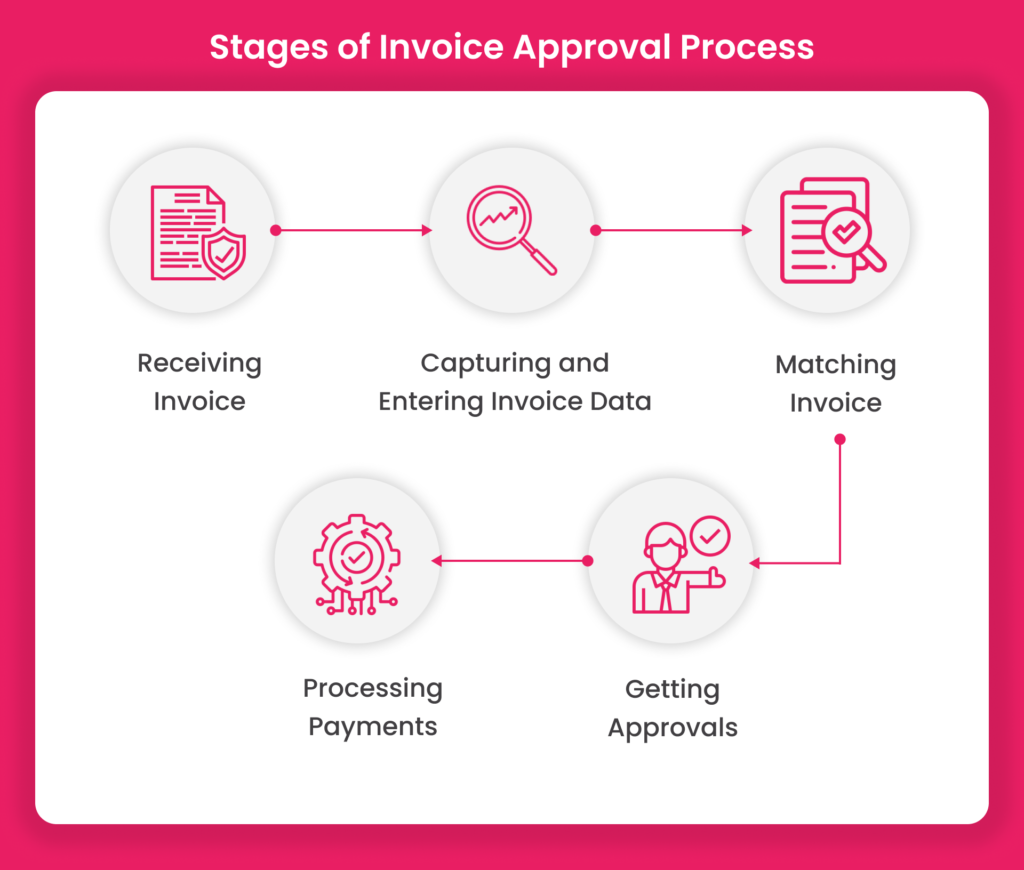The invoice approval process is key to managing finances in a company. It ensures that payments for goods and services are accurate, compliant, and efficient.
This process involves several people who review and approve invoices before payments are made. The goal is not only to prevent errors and discrepancies but also to establish a transparent and controlled workflow that aligns with organizational policies.
In this blog, we will explore invoice approval workflow, learn about its challenges, and understand how automation helps to establish a more efficient workflow.
What is an Invoice Approval Process?
An invoice approval workflow is a step-by-step process for reviewing and approving invoices before payment. It ensures invoices follow company rules, match what was received, and have the right paperwork. The main goal is to avoid errors, duplicate payments, and fraud, making sure the company only pays for valid and approved expenses.
Stages of Invoice Approval Process
The steps and people involved in an invoice approval workflow can differ based on the organization’s setup and rules. Usually, the process includes these stages:

Stage 1: Receiving Invoice
This is the initial step where the organization receives the invoice from the vendor. The invoice can be in various formats, including paper, pdf, or e-invoices. It’s crucial to ensure that all invoices are captured and entered into the system for processing.
Stage 2: Capturing and Entering Invoice Data
The information on the received invoice needs to be carefully entered into the organization’s accounting or ERP system. This includes details like the vendor’s name, invoice number, date, and amount due. It’s a time-consuming process and can easily lead to mistakes.
Stage 3: Matching Invoice
In this step, the entered invoice data is compared and matched against supporting documents, such as purchase orders and GRNs. Usually, companies employ a 3-way match to perform this task.
The purpose of invoice matching is to verify that the goods or services listed on the invoice were indeed received and aligned with the terms agreed upon in the purchase order. Any discrepancies or exceptions are flagged for further investigation.
Stage 4: Getting Approvals
After reviewing and matching the invoice and documents, the next step is to get approval. The invoice is sent to the right people based on set rules in the approval matrix. Approvers check that the invoice is correct, follows company rules, and fits the budget. Depending on the organization, multiple levels of approval might be needed.
Stage 5: Processing Payments
After the invoice has successfully navigated the approval process, it moves on to payment processing. The authorized invoice is forwarded to the accounting department, where the payment is initiated and the invoice is closed. This can involve various payment methods, such as electronic funds transfer, checks, or ACH.
Challenges of Traditional Invoice Approval Process
Let’s take a look at the challenges of the manual invoice approval process:
Decentralized Processes
Lost or missing invoices are a big problem for AP teams. They waste time juggling emails, texts, and systems without a central solution.
Time-Consuming Tasks
For the AP department handling a large influx of invoices, manually capturing invoice data, performing invoice matching, and routing approvals becomes a time-consuming and repetitive task. According to reports, the average time to process an invoice can range between 10 to 45 days.
Transparency Issues
Without clear visibility into invoice approval status, it’s hard for stakeholders to track progress and make informed decisions, which can affect compliance and financial processes.
High Operational Costs
Traditional invoice approval processes often involve higher operational costs. The need for physical document handling, data entry, and paper-based communication contributes to increased expenses, impacting cash flow. According to reports, the average cost of processing an invoice ranges from $10 to $40.
Error-Prone Operations
Manual data entry and approval are prone to mistakes like wrong data, misinterpretations, and oversights. These errors can lead to overpaid or underpaid invoices, causing financial problems for the organization in the long run.
Payment Delays
The cumulative effect of decentralized processes, manual handling, and delays in approvals can result in prolonged payment cycles. This delay causes strained vendor relationships, late payment penalties, and poor credit ratings.
Fraud Vulnerabilities
Manual invoice approval processes increase the risk of fraud, like tampered invoices or unauthorized approvals. Without strong controls and visibility, it’s easy for fraud to go unnoticed until it causes major problems.
Top 4 Strategies to Optimize Invoice Approval Process
1. Establish Clear Approval Policies
Define clear approval rules, detailing who can approve what and in what order. Create an approval chart showing different approval levels and their limits to ensure fairness and transparency.
2. Enhance Visibility with Real-Time Tracking
Use solutions that let you track and see the status of each invoice in real time. This transparency helps improve communication, solves problems early, and lets everyone make better decisions.
3. Integrate with Accounting Solutions and ERP
Integrate the invoice approval process with the organization’s ERP or accounting system. This integration ensures data accuracy, reduces duplicate payments, and facilitates seamless communication between different departments, leading to a more efficient and error-resistant workflow.
4. Implement Automation Solution
Use automation tools to simplify invoice approvals. These tools route invoices to the right people based on set rules, cutting down manual work, reducing mistakes, and speeding up the approval process.
Upleveling Invoice Approval Workflow with Procure-to-Pay Automation
Procure-to-pay solution eliminates the need for paper-based processes throughout the procurement cycle. It streamlines the purchasing process, from order placement to reviewing purchase orders to invoice processing, the solution automates each step of the process.
Procure-to-pay solution allows you to efficiently cross-check invoices with purchase orders and GRNs, fast-track approvals, and seamlessly capture and store invoice data.
Benefits of Automating Invoice Approval Workflow
Here are some of the many benefits of automating invoice approval workflow:
- Provide a single source of truth by consolidating purchasing and invoice data on a single platform.
- Improve productivity and reduce time spent on repetitive manual tasks.
- Lower transaction costs and improved visibility into trends and metrics.
- Fosters strong vendor relationships by speeding up invoice processing.
- Minimized human dependency resulting in fewer errors and a smoother workflow.
How Procure-to-Pay Solutions Benefit the Stakeholders
How Peakflo Helps in Invoice Approval Workflow
- Automatically capture invoice details such as name, discount, tax, etc. through OCR
- Sync all the details with your existing tech stack.
- Seamlessly perform invoice matching with a few clicks and identify mistakes even on line items.
- Create approval workflow as per your business needs.
- Automate payouts based on the due date of the invoices.










![Why AI Sales Calls Are Making Good Sales Reps Even Better [2025 Guide] ai sales calls](https://blog.peakflo.co/wp-content/uploads/2025/09/65168cf6-3001-4733-8cbc-12d5684cf449-218x150.webp)



































